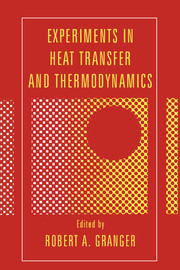Book contents
- Frontmatter
- Contents
- Preface
- Introduction
- Part I Experiments in heat transfer
- I.1 Conduction
- I.2 Convection
- I.3 Boiling
- Experiment 17 Capillary-tube boiling
- Experiment 18 Two characteristic regions of nucleate pool boiling and corresponding change of hydrodynamic state
- Experiment 19 The boiling slide
- Experiment 20 Evaporation and boiling in sessile drops on a heated surface
- I.4 Mixing, dispersion, and diffusion
- I.5 Radiation
- I.6 Heat pipes and exchangers
- Part II Experiments in thermodynamics
- Appendix 1 Experiments and demonstrations in thermodynamics
- Appendix 2 Experiments and demonstrations in heat transfer
- Appendix 3 Heat-transfer and thermodynamic films
- Index
Experiment 17 - Capillary-tube boiling
Published online by Cambridge University Press: 05 June 2012
- Frontmatter
- Contents
- Preface
- Introduction
- Part I Experiments in heat transfer
- I.1 Conduction
- I.2 Convection
- I.3 Boiling
- Experiment 17 Capillary-tube boiling
- Experiment 18 Two characteristic regions of nucleate pool boiling and corresponding change of hydrodynamic state
- Experiment 19 The boiling slide
- Experiment 20 Evaporation and boiling in sessile drops on a heated surface
- I.4 Mixing, dispersion, and diffusion
- I.5 Radiation
- I.6 Heat pipes and exchangers
- Part II Experiments in thermodynamics
- Appendix 1 Experiments and demonstrations in thermodynamics
- Appendix 2 Experiments and demonstrations in heat transfer
- Appendix 3 Heat-transfer and thermodynamic films
- Index
Summary
Principle
The process of nucleate boiling from a heated surface involves bubble formation, bubble emission, and liquid replacement in a cyclic manner. The phenomenon is strictly periodic at low heat fluxes, becoming gradually aperiodic as the heat flux increases.
Object
This is an experiment to provide some understanding of the complex phenomena that occur during liquid-to-vapor phase change. The geometry is greatly simplified so that the process can be easily controlled and most of the results visually observed. Periodicity and aperiodicity of the bubbling can be quantitatively analyzed through a study of the bubble departure periods.
Apparatus
Figure 17.1 (not to scale) shows the arrangement used in the experiment. The capillary tube in which boiling is to be studied is constructed in the following manner. A thin electrical heater wire (of constantan, diameter 75 μm, for instance) is uniformly roughened with emery paper to discourage preferential nucleation at any particular spot on its surface. It is then run down the center of a 1–3-mm-diameter glass capillary; a 4–7-cm length of this capillary tube is closed off by heating over a flame. A DC power source supplies variable current to the electrical wire. The power from this source can be determined by measuring its voltage and amperage. The length of the wire should also be determined to provide the heat flux in W/m of the heater length.
- Type
- Chapter
- Information
- Experiments in Heat Transfer and Thermodynamics , pp. 127 - 134Publisher: Cambridge University PressPrint publication year: 1994
- 1
- Cited by



